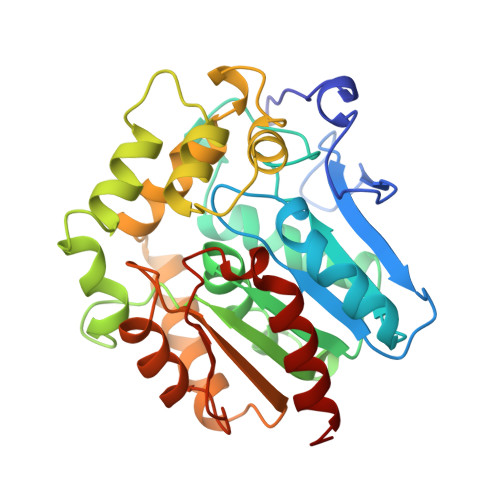Kinetic characterization and X-ray structure of a mutant of haloalkane dehalogenase with higher catalytic activity and modified substrate range.
Schanstra, J.P., Ridder, I.S., Heimeriks, G.J., Rink, R., Poelarends, G.J., Kalk, K.H., Dijkstra, B.W., Janssen, D.B.(1996) Biochemistry 35: 13186-13195
- PubMed: 8855957
- DOI: https://doi.org/10.1021/bi961151a
- Primary Citation of Related Structures:
1HDE - PubMed Abstract:
Conversion of halogenated aliphatics by haloalkane dehalogenase proceeds via the formation of a covalent alkyl-enzyme intermediate which is subsequently hydrolyzed by water. In the wild type enzyme, the slowest step for both 1,2-dichloroethane and 1,2-dibromoethane conversion is a unimolecular enzyme isomerization preceding rapid halide dissociation. Phenylalanine 172 is located in a helix-loop-helix structure that covers the active site cavity of the enzyme, interacts with the C1 beta of 1,2-dichloroethane during catalysis, and could be involved in stabilization of this helix-loop-helix region of the cap domain of the enzyme. To obtain more information about the role of this residue in dehalogenase function, we performed a mutational analysis of position 172 and studied the kinetics and X-ray structure of the Phe172Trp enzyme. The Phe172Trp mutant had a 10-fold higher Kcat/Km for 1-chlorohexane and a 2-fold higher Kcat for 1,2-dibromoethane than the wild-type enzyme. The X-ray structure of the Phe172Trp enzyme showed a local conformational change in the helix-loop-helix region that covers the active site. This could explain the elevated activity for 1-chlorohexane of the Phe172Trp enzyme, since it allows this large substrate to bind more easily in the active site cavity. Pre-steady-state kinetic analysis showed that the increase in Kcat found for 1,2-dibromoethane conversion could be attributed to an increase in the rate of an enzyme isomerization step that preceeds halide release. The observed conformational difference between the helix-loop-helix structures of the wild-type enzyme and the faster mutant suggests that the isomerization required for halide release could be a conformational change that takes place in this region of the cap domain of the dehalogenase. It is proposed that Phe172 is involved in stabilization of the helix-loop-helix structure that covers the active site of the enzyme and creates a rigid hydrophobic cavity for small apolar halogenated alkanes.
Organizational Affiliation:
Laboratory of Biochemistry, BIOSON Research Institute, Groningen Biomolecular Sciences and Biotechnology Institute, University of Groningen, The Netherlands.














